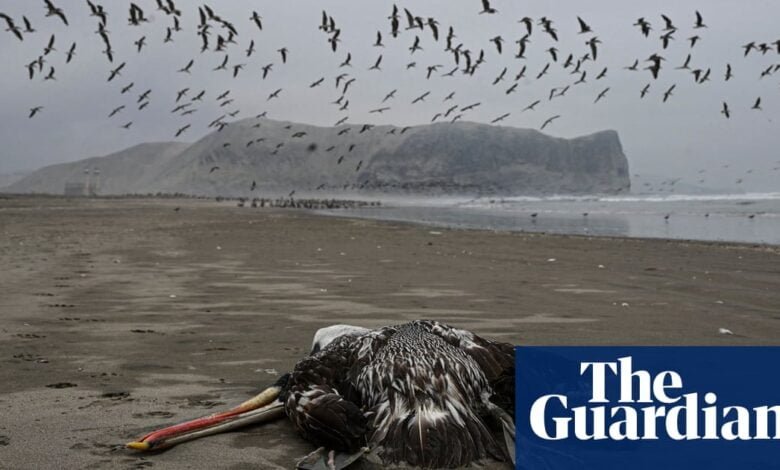Bird flu pandemic risk high as cow cases appear and officials warn of humans’ role | Bird flu

Bird flu cases among animals continue to rise as US officials warn about the role of humans in spreading the virus.
There are now 102 herds in the US with H5N1 cases, though given the prevalence of inactivated virus in commercially available pasteurized milk, experts believe the true number may be even higher.
Poultry operations have reported cases likely linked to dairy farms, indicating the virus may be spilling back from cows into birds. Nearly 97m domesticated birds in the US have been affected by the highly pathogenic influenza since 2022.
Although officials believe this outbreak was originally sparked by a single introduction from migratory birds into cows – for instance, via feed contaminated by bird feces – late last year, genomic analyses now suggest it is being spread between animals and farms by human activity, according a report released by the US Department of Agriculture (USDA) on Thursday.
The report, which focused on cases in Michigan, found that transmission is likely happening when workers, cows, vehicles and equipment go to multiple farms.
Among employees at dairies with outbreaks, one in five employees work at other dairies and 7% work on poultry operations as well. That’s in addition to the veterinarians, nutritionists and haulers who regularly visit multiple farms.
Three in five Michigan dairies with outbreaks use shared vehicles to transport cows, but only 12% clean the vehicles first. All but one of the affected dairies belong to the same milk co-ops.
The results are in line with a second report also released by the USDA on Thursday, showing that about one-third of employees at US dairies with outbreaks also work on other farms with livestock – usually dairy farms, but sometimes swine and poultry.
More than half of affected dairy farms across the US share trucks and trailers to transport cows, and more than half of those who share vehicles don’t clean them first, the report said.
“Biosecurity is the key to prevention,” Kammy Johnson, a veterinary epidemiologist with the USDA’s Animal and Plant Health Inspection Service, told reporters on Thursday. That means decontaminating everything that goes from farm to farm – transportation, clothing, equipment – and reducing the chances of infected animals, or people, passing the virus onward.
It’s not clear if the outbreak is continuing to gain force, officials said, but they expect to find more cases in cows.
And, as the virus evolves, it could become more of a threat to people, according to a recent report by the US Centers for Disease Control and Prevention (CDC). Officials expect to see more bird flu cases among humans as the outbreak continues, the report said.
“The more infections there are among cows, the more risk there is for infections to occur among humans,” Dr Nirav Shah, principal deputy director of the CDC, told reporters on Thursday.
“The fact that it’s in 20% of our milk supply should be disturbing to everyone because that means it’s gone around already,” Xavier Becerra, secretary of the Department of Health and Human Services, said last week. “If it starts to jump, that’s when we really have to worry.”
Yet testing has lagged, in a situation reminiscent of the Covid-19 pandemic.
The only authorized test for H5N1 among humans comes from the CDC, and it is only available to people who have symptoms and a history of close contact with infected animals or other people. So far, there have only been 45 tests performed this year.
Yet there have been reports of workers with positive flu A tests that are not sequenced for H5N1, as well as potential missed cases, like the farm workers and a local maternity worker who reported flu-like symptoms near the first confirmed human case this year in Texas.
Providers may now be reluctant to test for influenza even if a patient has respiratory symptoms, since the flu season has ended and thus insurance companies may not pay for the tests.
The USDA requires lactating dairy cows to be tested before moving across state borders. The federal government does not have the authority to require testing of animals or people on a wide scale, which means these efforts largely fall to state and local entities.
In Wisconsin, for instance, which has not yet announced any infections in cows, farmers are now required to test cows before taking them to fairs and exhibits.
Cows have died in at least five states – South Dakota, Michigan, Colorado, Ohio and Texas – because they didn’t recover or developed secondary infections after testing positive for H5N1. The majority of infected cows recover, but these deaths indicate the potential financial burden of an uncontrolled outbreak.
Barn cats and mice have also tested positive for H1N1, raising concerns the animals could spread the virus in communities beyond the farms.
Source link




